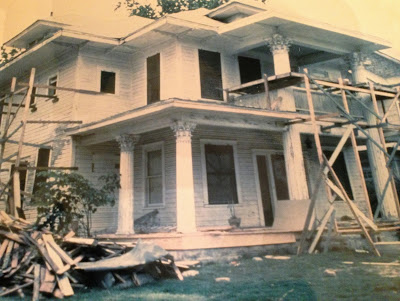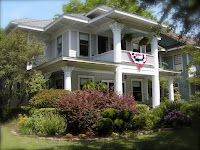The first time I woke to the unmistakable smell of chocolate streaming from the air-conditioner vent over head, I glanced at the time on the bedside table, threw back the duvet and slogged downstairs half asleep. 1:35 a.m.?Although our chocoholic daughter was only a sixth grader at the time, she was independent and resourceful and knew her way around the kitchen better than most adults. But 1:35 a.m. was too late (or early) for anyone to bake brownies.
The orange glow of the coffeepot clock provided the only light in the otherwise dark kitchen. Our new oven was cold. No fresh brownies waited on the countertop for late night snacking.
We had only begun to learn about our new home, to feel comfortable with her creaky heart-of-pine floors and other quirks that come with old age. Our home purchase was basically an accident. We stumbled into the open house on a whim—no thanks, just browsing. One week later we were in escrow. Sometimes what you need jumps out and knocks you down.
What had we gotten ourselves into? Had we inherited a brownie-baking ghost?
The second time I woke to that familiar aroma, I smiled, rolled over and fell back asleep, considering the delicious smell all part of our new (old) house’s appeal. I decided to dig into the lives of the people who came before us, the folks would built and preserved the house for us.
Looking back is often the best way to see ahead.
Influenced by Frank Lloyd Wright, our prairie-style, four square home was designed and built in 1910 by Lang & Witchell, a significant architectural firm that designed prominent Dallas buildings in the early to mid-1900s including Exposition Hall at Fair Park and the Adolphus Hotel. Located in historic Munger Place, our home is part of the nation’s largest collection of prairie-style homes. The history drew us to the area. The charm keeps us here.
I imagine the amazing things our house has witnessed through the years as the city grew up around it.
If these walls could talk we might hear stories of social gatherings like the event reported January 9, 1915 in the Dallas Morning News …
The Bay View Century Club … has taken up the study of art, using as a textbook Van Dyke’s The Art of the World. The first two chapters dealing with early Egyptian art will be discussed at next week’s meeting in open social session with Mrs. J. J. Hart, 5119 Worth Street.
In 1917, we might hear romantic honeymoon stories…
Mr. and Mrs. Walter Graner have just returned from their wedding tour and are at home at 5119 Worth Street. Mr. Graner, a ten year resident of Dallas, married Miss Marie Weaks on June 13 at the bride’s home in Lebanon, Tennessee. (Dallas Morning News, June 23, 1917)
And tales of looming war…
With the arrival of most of the troops that are due to undergo training here, Camp Bowie is now settling down to hard work and hard drilling. From early morning until the late afternoon the hillsides and valleys of the huge campus are dotted with groups of soldiers in khaki who are drilling as if their lives depended on it…about five hundred additional guardsmen reached Camp Bowie today including First Lieutenant Walter Graner, et. al. (Dallas Morning News, September 11, 1917)
Illness and death settled between the walls of 5119 Worth during the stifling summer of 1922…
Reade Macon Washington, a resident of Dallas for 35 years, died Wednesday morning at his home, 5119 Worth Street following an illness of about a year. Mr. Washington was born January 1, 1848 in Pittsburgh, Pa, and was the son of Major Edward C. Washington, an officer in the Union Army who was killed at Vicksburg while commanding that regiment as its senior officer. In Mr. Reade Macon Washington of Dallas was preserved the name and the blood of the father of this country. He was the great-grandson of George Washington’s uncle. His grandfather and namesake (also Reade Macon Washington) was George Washington’s first cousin. (Dallas Morning News, July 13, 1922 & February 9, 1894)
And again fourteen years later…
Mrs. Leila James Wilson Washington, 82, resident of Texas since 1853, died Saturday at her home, 5119 Worth Street. Mrs. Washington was born in Virginia, August 11, 1853, and was brought to Texas by her parents, Samuel and Cornelia Wilson, when she was an infant. The move was made by carriage and wagon, furniture and slaves being brought along. Many pieces of the furniture still are in the home of the family. In 1875, Mrs. Washington was married to Stanley W. McFadden of South Carolina. He died in 1890 and in 1897 she married Reade M. Washington of Chambersburg, Pa, who is also dead now. (Dallas Morning News, February 9, 1936)
Post World War II, Munger Place was in disrepair, the collection of historic homes nearly lost. Like many East Dallas homes, 5119 Worth was converted to multi-family for returning soldiers. Five apartments were built onto the back of the house to accommodate renters. (This explains why each time we dig a hole to plant a shrub or flower, we uncover an antique brick…)
Later, 5119 Worth was used as a home for recovering alcoholics.
In the 1970s, a new owner demolished the apartments and returned the home to single-family status. During 1980 renovations, a Marilyn Monroe Life Magazine from the 1950s was discovered hidden in the wall.
We’ve lived at 5119 Worth eleven years now along with our late night baker—perhaps Mrs. Washington? We’ve made additional improvements to the house we love, the house that’s become part of us.
One hundred years from now will our family be known for anything in particular? Maybe, maybe not. The thing I do know—we will leave our special place better than we found it. We are merely caretakers.
talya
Grace Grits and Gardening
Farm. Food. Garden. Life
p.s. Our home will be open today as the Historical Exhibit for Munger Place Days. Come by!












